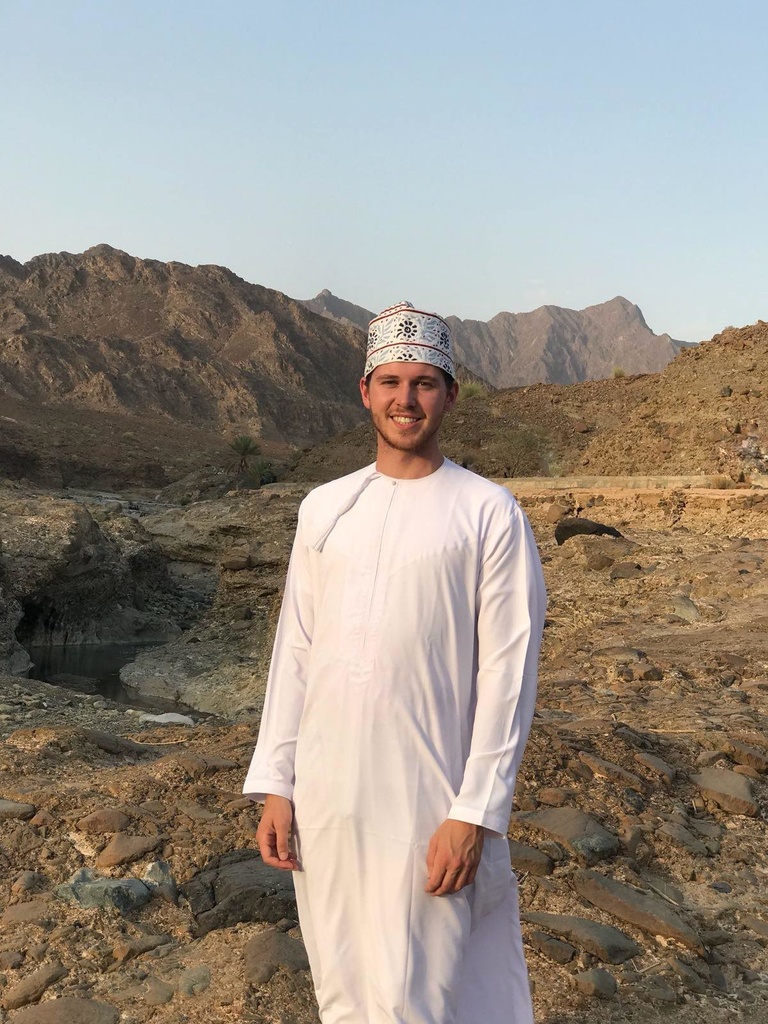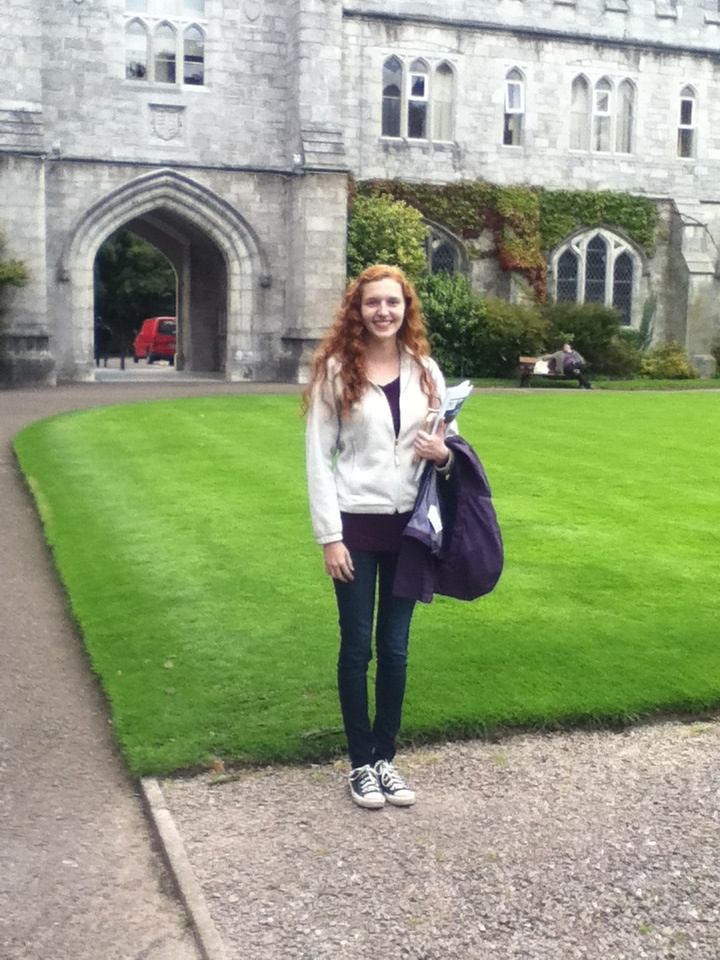
One of our program directors hosted us in the countryside for an iftar dinner last weekend about an hour north of Ibri in the village of Mahyul. The wadi views were incredible.
Alex Bare is a rising senior (international relations and Spanish) and 2018 recipient of the Critical Language Scholarship, an intensive overseas language and cultural immersion program for American students funded by the U.S. Department of State. Views posted herein do not represent those of the Department of State, American Councils for International Education, or the CLS Program.
Two things:
It sand stormed this week, like no other. Just check out the video.
While I accompanied my language partner to run some errands, a dust storm whipped up and clouded over the sky. It hit 119ºF this same day.
And…
Eid al-Fitr, the holiest Islamic holiday is here! كل عام وأنتم بخير!وعيد مبارك
It’s 4 a.m. Omani time and I just finished suhoor, a.k.a. pre-sunrise breakfast. With some encouragement from Muslim friends back in the U.S., I have dedicated myself to abstaining from eating or drinking from sun up to sun down, as the whole Muslim world does during the Ramadan holy month. Mad respect to all my Muslim friends at Iowa who are fasting...your minds are so powerful.
I am now settled quite well in my host city of Ibri, about 2.5 hours from Muscat on the other side of the rugged Hajar Mountains. Ibri is the capital of the Adh Dhahira Governorate, a region straddling the eastern edge of the Arabian Desert’s Empty Quarter (read: no man’s land). The empty quarter is a massive region of rolling sand dunes the size of France with virtually no inhabitants or rainfall each year, and Ibri is an ideal dumping ground for its sandstorms. The only ingredient necessary: wind.
All 28 American students in my program were paired with language partners last week, who meet with us 3 times weekly at the institute to practice Arabic and host us for 4-weekend homestays during the summer. In years before, students on the Critical Language Scholarship in Oman lived with host families, but due to intense cultural differences (I’ll get into shortly), that is no longer the case.
My language partner in Oman is AWESOME and I’m not sure what I would do without him. This past weekend, I visited his home and had my first immersive experience in Omani culture.
Before being sent to my language partner’s home, we were warned that it is very likely that male students will never see their host “mother” or any women in our host family, and that some families may not permit men to leave the guest entertainment room. This was true for my host family. My language partner lives in a beautifully furnished home north of Ibri and has 7 siblings. During the 4 hours I spent there, I met his father, brother, brother-in-law, and 2-year-old niece. A woman handed food through the door to my language partner, but otherwise, I never interacted with women.
After breaking fast with my language partner, we headed to a theater competition, where the audience was segregated between women on the right side of the aisle and men in the left. Even married couples separated, although young children were exempt. Gender segregation is pretty standard across the board due to the conservative nature of Omani society, which is partially influenced by the type of Islam practiced here.
Unlike all other Islamic countries in the world, Oman is neither Sunni more Shia, but Ibadi. To prevent the sectarian rifts that plague countries like Iraq and Lebanon, the Omani government does not publish religious or ethnic demographics, although it’s generally thought to be something like this:
- 55% Ibadi
- 35% Sunni
- 5% Shi’a
- 5% Hindu/Christian (all expatriates from South Asia)
Whereas Sunnis and Shias generally believe condemnation to hell is finite and that the soul will eventually progress to heaven through the mercy of Allah, Ibadis believe in the finality of eternal damnation. This means they take extra care to avoid activities that are ambiguously haram, such as smoking or even being rude to other people.
Culture shock has been especially difficult for the Arab women in my program, who aren’t used to this level of conservatism even in their family’s home countries. Students who packed clothes with Iraq or Lebanon in mind found most of their clothes unacceptable to wear in public. In Ibri, I would estimate the most popular type of women’s garb is:
- 90% wear black abayas (long robes) with matching black headscarf, or shayla (known as a hijab elsewhere), but shades of pink and tan seem to be somewhat popular among younger women
- 10% wear the niqab (black robe with slit cut out for the eyes) or the bushiyya, which is similar to the burqa in that it covers the entire face with a semi-transparent fabric
- Less than 1% wear the Omani burqa, which is much more popular in the countryside and harder to explain, so I’ll link this article
I’ll save men’s clothes for next week. Note: people dress more conservatively during Ramadan than the rest of the year. Also, expatriates from South Asia, who make up 1/3 of Oman’s population, generally do not wear head coverings.
It is true that the Western world has a strange obsession with Islamic head coverings. It is therefore ironic that I write this, but I do think it is important to address this considering the oft-heard stereotypes about head coverings. The hijab/abaya are sometimes interpreted as a symbol of oppression that should be banned, which can be a dangerous and oft-used justification for the superiority of white, Western culture over Islamic society. Here, head coverings are seen as no stranger than wearing “sunglasses or earrings,” as this great article puts it. At the same time, however, gender segregation and mandatory head covering are an entirely separate realm, but I am limited on how I can comment due to Oman’s laws that restrict politically objectionable views.
All the members of my cohort have begun adjusting slowly but surely. Some of us (me included) wear abayas/shaylas or dishdashas (as men’s robes are called) out of respect for our instructors and the Omanis we work with every day, who visibly appreciate it.
My language partner graciously took me to the tailor’s shop last week to help me get fitted for a dishdasha and kumma (cap), which I wear to class and on outings with Omanis. It was wonderful, even if I still don’t understand half of the things he says to me. On the drive back, the adhan (call to prayer) echoed from mosques across the city, and he pulled over at a roadside prayer spot to break our fast with dates, laban, and chicken biryani rice. Minutes later, traffic returned to the streets and life carried on.
Just another Ramadan evening in the Sultanate.

Interested in going abroad? Learn more about first steps